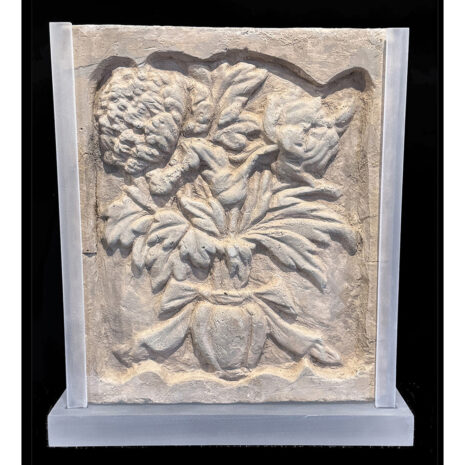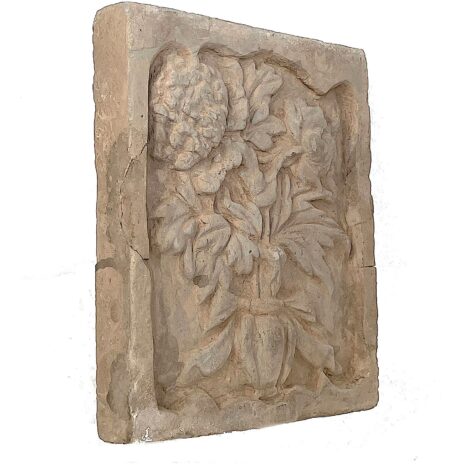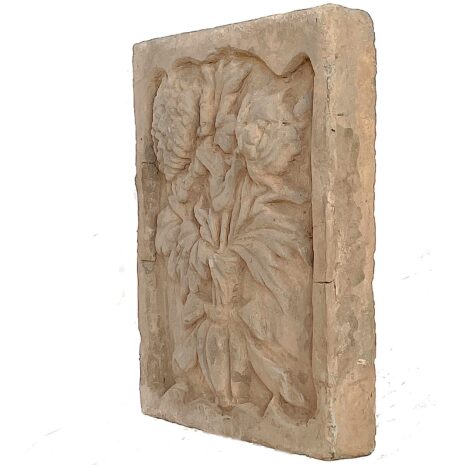SOLD Song Dynasty Tile of Vase with Flowers, China (3347BLE) $995 with Acrylic Stand
$995.00
H: 11” W: 9.5” D: 1.65” | FREE SHIPPING
This earthenware brick tile bordered with a deep scalloped frame depicts a vase with a bouquet of propitious flowers: a chrysanthemum and a peony wrapped with an elegant ribbon. Tiles like this were made to decorate the large numbers of buildings created during the prosperous Song dynasty and to adorn tombs. This elegant brick is in good condition for its age with expected chips and cracks, some restoration of background and a re-glued frame break on each side. It has earth adherents from its burial in a tomb.
Out of stock
Description
During the Song Dynasty earthenware unglazed brick tiles made using a mould were produced to decorate inner chamber walls of tombs and government and public buildings. Used as funerary decorations to wish the deceased happiness and comfort in their afterlife, these Song Brick Tiles are another example of a mingqi ancestral item. Without knowledge of Chinese homophones, rebuses, cultural symbols and tonal languages, one might think this is a boring Song tile but the opposite is true. The tile is a wish for all to have a healthy life with longevity, wealth, rank, status and honor. Blooming flowers, fruits and plants are seen as auspicious as they produce fruit and are a well recognized homophone. Homes are decorated with blossoms at the Chinese New Year to welcome coming prosperity, and a vase full of flowers is a homophone meaning “may everything be auspicious.” A vase (ping) is a pun and a symbol for peace, the elixir of life and the realization of all one’s wishes and the long ribbons (shoudai) and bow around the vase symbolizes longevity (shou). Chrysanthemums symbolize a happy life and the joy of returning to nature in middle or old age from a hectic life and wine and tea from its petals are said to extend life and encourage good health. Called the “king of flowers” (fuguihua) the peony is an auspicious symbol of wealth (fu) and a wish for high rank (gui). As imperial gardens were rich with peonies, they are related to royalty, linked to female beauty and, according to Welch, “…a hint of erotic lushness.” (p. 36) Most ancient buildings containing these pieces used traditional un-reinforced fired mud/brick construction and were subject to disasters like earthquakes, floods, fires, and war so few survived intact and often require repair or restoration. Set in a stunning acrylic framed mount it is featured in a VA instagram post.
Sources
Terese Tse Bartholomew, Hidden Meanings in Chinese Art, San Francisco, Asian Art Museum of San Francisco, 2006.
Patricia Bjaaland Welch, Chinese Art: A Guide to Motifs and Visual Imagery, Rutland, Tuttle Publishing, 2008.
Additional information
| Weight | 13 lbs |
|---|---|
| Dimensions | 18 × 12 × 6 in |
| Place of Origin | China |
| Period | Ancient, Song Dynasty |
| Materials and Technique | Earthenware |
| Dimensions (inches) | Ht: 11” W: 9.5” D:1.65” |
| Dimensions (metric) | Ht: 28cm W: 24cm D: 4.2cm |
| Weight | 9 lbs |
| Condition | Good condition with repairs, see description |
| Item Number | 3347BLE |
| Shipping Box Size |






